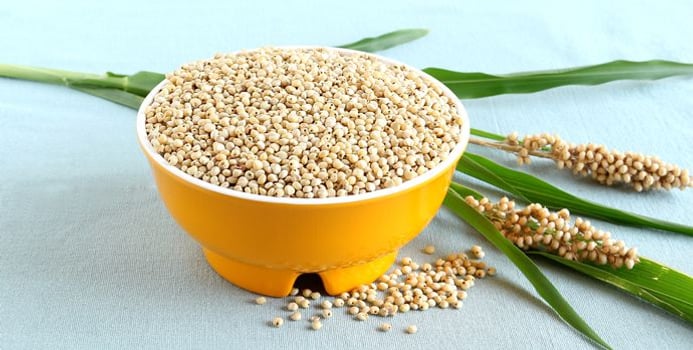Perhaps you have not yet encountered sorghum — unless you're from the American South — but it should definitely be on your radar. In the South, sorghum is used as a sweetener much like honey or molasses. But this ancient cereal grain can do so much more. To start, sorghum is gluten-free, meaning it is a safe staple grain for people with celiac disease or gluten sensitivity.
Although sorghum has most commonly been used in the culinary world as a syrup, you can also use it as a grain or grind it up to make a gluten-free flour. But sorghum won’t stop there — you can also pop it just like popcorn. You can find sorghum kernels in a variety of colors from white and pale yellow to deep reds, purples and browns; white, bronze, and brown kernels are the ones you will see most often.
Because there is a higher prevalence and awareness of celiac disease (a chronic medical condition for which patients must strictly remove gluten from their diets in order to avoid damage to their intestines), the gluten-free market has seen booming success in recent years. Sorghum is gluten-free and therefore safe for those with celiac disease, but it can and should be enjoyed by everyone because it is a delicious, versatile, nutrient-dense whole grain.
Nutrition
Since sorghum grows from traditional hybrid seeds, it is not a genetically modified organism (GMO). Regardless of how you feel about biotechnology, some consumers are making the decision to avoid GMOs, and knowing sorghum is non-GMO may make purchasing this healthy whole-grain easier.
Sorghum is a whole-grain, meaning you eat the entire kernel, including the nutrient-rich outer layer that houses all of the fiber and beneficial phytochemicals, particularly disease-fighting antioxidants. In fact, some scientists say that certain compounds called policosanols found in the wax that surrounds the sorghum grain might benefit your heart because of their cholesterol-lowering abilities.
Nutrition Facts
- Per 1 ounce sorghum, uncooked:
- Calories: 96
- Fat: 1 gram
- Carbohydrates: 21 grams
- Dietary Fiber: 2 grams
- Protein: 3 grams
Health Benefits
Improves Digestive Health — One serving of sorghum provides you with 48 percent of the recommended dietary intake (RDI) of belly-benefitting fiber.
Helps Prevent Heart Disease and Stroke — Sorghum’s fiber helps rid your body of some bad (LDL) cholesterol, thus preventing plaque buildup called atherosclerosis. Atherosclerosis can lead to heart disease and stroke.
Helps Ward Off Cancer — Sorghum’s outer layer is chock-full of cancer-crushing antioxidants that are not common in other foods. Research has found that these particular antioxidants, especially ones called 3-deoxyanthoxyanins, can lower your risk of getting cancer of the esophagus, colon, and skin.
Derails Diabetes — Several studies have shown that certain types of sorghum house large amounts of antioxidants and polyphenols that impede protein glycation, and advanced glycation endproducts (AGEs) have been suspected in the development of diabetes and its subsequent complications.
Recipe Ideas
Sorghum is described as tasting neutral to slightly sweet, making it an easy grain to incorporate into any diet, even if you are a picky eater.
*You can “pop” sorghum, and it is very similar to popcorn, just a little smaller.
*Make a sorghum pilaf, or combine sorghum with other whole grains such as brown rice or quinoa to make a truly unique, satisfying, savory side dish.
*Sorghum can be used to make a hot breakfast cereal and also works well in casseroles and soups.
*You can use sorghum flour just like you would whole wheat flour, but keep in mind that it contains no gluten so you may have to add a binding agent, such as cornstarch or xanthan gum to some recipes.
*Use sorghum flour in your favorite breads, pancakes, muffins, and pizza crusts.
[Image via Shutterstock]



